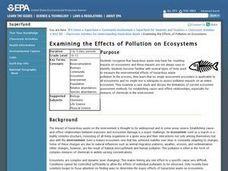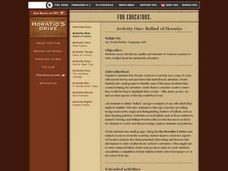Curated OER
The Very Hungry Caterpillar - Collage Technique
First graders listen to the story The Hungry Caterpillar, then sequentially organize their own re-writing and re-creating of the story. They construct illustrations for their book using the collage technique Eric Carle used in his...
Curated OER
A Piece of Cake
Students examine life under the sea to discover coral gardens and microhabitats. They demonstrate learning by creating an edible marine ecosystem with a sheet cake, icing, and different candies.
Curated OER
50th Anniversary of Brown v. Board of Education
Students examine a poster of Brown v. Board of Education and discuss what the important details are. They read the story behind the poster and court case. They role play different sections of the case such as the court case or Linda...
Curated OER
Persuasive Poster
Young scholars examine the effects of visual media in advertising/propaganda and how posters can influence a person's ideas. They create their own persuasive poster to convey a chosen message.
Curated OER
Watergate Revisited
Students review Watergate Files and the Watergate Trial using Internet sites. They read about the people involved in Watergate. They discuss the events leading up to and after Watergate.
Curated OER
What Makes Bones Strong?
Students explore the function of bone, muscle, and skin. Pasta and rubber bands are used to model how minerals and collagen contribute to bone strength. The effects of the reduction of these substances are explored in chicken bones.
Curated OER
Story Starters
Young scholars orally tell different types of stories using the assistance of props. For more advanced students, stories may be told according to a specific genre, or the story may have to include a given condition, setting, situation or...
Curated OER
Kidney Pools: Are They Fair?
Students examine the kidney donation process and make ethical decisions as various stakeholders in specific case studies. They decide which candidate should receive a kidney donation.
Curated OER
Manufacturing Technologies: Making a Picture Frame
Students use cereal boxes, paint, buttons and glue to design and make a frame for a photograph. They consider the different processes involved in making the frame and discuss how their observations apply to manufacturing systems that are...
Curated OER
Examining the Effects of Pollution on Ecosystems
Young scholars examine the different types of tests used to measure the environmental effects of hazardous waste. They work together to determine the impact of pollution on different ecosystems. They read a case study and answer...
Curated OER
The O.J. Verdict
High schoolers research the main points of the accusations against O.J. Simpson, the prosecution and defense strategies and the outcome of the infamous murder trial. They participate in a mock trial, view a film, read articles and...
Curated OER
Horatio's Drive
Students assess the literary quality and elements of Jackson's journey to write a ballad about his automobile adventure.
Curated OER
The Art of Social Protest
High schoolers investigate how art and music define and unify a social movement. They decide how art and music can act as symbols of protest. They view both contemporary and historical examples of art as a tool for protest and design an...
Curated OER
Vanishing Verbs
Students analyze recent media trends, and develop critical thinking skills by summarizing main ideas, extracting details, formulating opinions, drawing inferences, and comparing and contrasting attitudes. They also practice paraphrasing...
Curated OER
Food and Your Body -- How to Maintain a Healthy Diet
Students examine the different food groups on the food pyramid. In groups, they discover the proper amount to eat from each food group and how to prepare healthy meals. They keep a food journal and calculate the amount of calories they...
Curated OER
How Do Artists Get Their Ideas? Culture and Environment as Sources of Ideas
Students share the difficulties they have in determining what to write or draw for a project. In groups, they view examples from three different artists and discuss how their personal experiences affected their art. They brainstorm a...
Curated OER
The Election
Students participate in an election. They are asked to vote for one of four candidates without knowing who they are or what they stand for. Students gain an important lesson when voting to make sure that security of freedom and...
Curated OER
Variations of Pain
High schoolers listen to the song :King of Pain" by the Police. They identify different instrumentation and different rhythmic accompaniments to the opening vocal phrase and explore the text in-depth, discussing the various poetic...
Curated OER
Vocal Awareness
Learners explore the human voice through teacher-directed exercises and experiments in the Kindergarten or 1st grade general music classroom. Textbook references are mentioned and an assessment pattern is given.
Curated OER
Building a Water Clock
Students research water clocks online, investigate how water clocks work, and construct water clock that will keep time accurately for at least two hours without human intervention.
Curated OER
Roy G. Biv Has Feelings Too
Young scholars test their memory recall and discuss its association to color. After reading an article, they discuss the natural and psycho-sociological significance of the color red. As a class, they participate in a mood-color...
Curated OER
Everyday Objects
Students reflect in their journals about an everyday object they take for granted. After reading an article, they examine what a cook's tools can reveal about their life. In groups, they research everyday objects and write a museum...
Curated OER
Silhouettes and Interiors
Students create a multimedia piece that integrates drawing and collage. Students learn about metacognition and the discovering of self through genres of art and literature by using these steps: inspiration, brainstorm, application,...
Curated OER
The Giving Tree
Fourth graders participate in a shared reading of The Giving Tree. They discuss the relationship between trees and people in the story. Students contribute to a class KWL chart. They create their own KWL chart with at least four things...

























